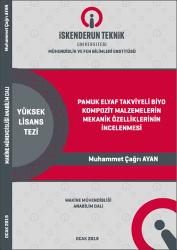| dc.contributor.advisor | Yapıcı, Ahmet | |
| dc.contributor.author | Ayan, Muhammet Çağrı | |
| dc.date.accessioned | 2019-07-16T10:57:27Z | |
| dc.date.available | 2019-07-16T10:57:27Z | |
| dc.date.issued | 2019 | en_US |
| dc.date.submitted | 2019 | |
| dc.identifier.citation | Ayan, M. C. (2019). Pamuk elyaf takviyeli biyo kompozit malzemelerin mekanik özelliklerinin incelenmesi (Yüksek Lisans Tezi). İskenderun Teknik Üniversitesi / Mühendislik ve Fen Bilimleri Enstitüsü, Hatay. | en_US |
| dc.identifier.uri | https://hdl.handle.net/20.500.12508/961 | |
| dc.description.abstract | Artan çevre bilinciyle beraber, son zamanlarda daha az kalıcı etki bırakan, çevreyi daha az kirleten ürünler ve üretim yöntemlerine ilgi de artış görülmektedir. Doğal polimerler, geri dönüştürülebilir poşetler, karbon salınımını en aza indiren elektrikli araçlar bunlardan birkaç tanesidir. Kompozit malzemelerde doğal liflerin kullanımı sürdürülebilirlik ve geri dönüşüm gibi kavramların ön plana çıkmasıyla son yıllarda hızla artış göstermektedir. Takviye materyali olarak kullanılan doğal liflerin geri dönüştürülebilirlik ve biyolojik olarak parçalanabilirlik ve özellikleri, yüksek özgül mukavemet, düşük yoğunluk değerlerine ek olarak bitkisel kökenli doğal kaynakların yenilenebilir olması sebebiyle ekolojik malzemeler gelişim göstermektedir. Doğada canlılardan oluşan ve hücrelerden meydana gelen doğal lifler hayvansal ve bitkisel lifler olmak üzere 2 grup içinde sınıflandırılmaktadır. Örneğin ağaç bir kompozittir, lignin adı verilen çok daha zayıf bir madde ile bir arada tutunan uzun selüloz liflerinden (bir tür polimer) oluşur. Selüloz aynı zamanda pamuğun içinde de bulunur, fakat onu bağlayan lignin maddesi olmadan pamuk çok daha mukavemetsizdir. İki zayıf madde lignin ve selüloz birlikte çok daha güçlü bir malzeme oluştururlar. İstenilen özelliklerde ve biçimde kompozit malzeme üretimi için bir çok yöntem bulunmaktadır. Bu çalışmada, doğal lif takviyeli kompozit malzeme üretiminde en sık kullanılan yöntem olan vakum infüzyon yöntemi ile biyo kompozit malzeme üretimi ve bu malzemelerin cam elyaf, karbon elyaf takviyeli kompozitlere kıyasla mekanik özelliklerinin incelenmesi amaçlanmıştır. Aynı ağırlığa sahip cam elyaf takviyeli, karbon elyaf takviyeli, yarı mamul biyo kompozit ve kumaş halinde nihai ürün olan biyo kompozit malzemelerden olmak üzere 4 tip kompozit malzeme üretimi vakum infüzyon yöntemi ile gerçekleştirilmiştir. Elde edilen plakalar standartlara uygun bir şekilde kesilerek mekanik testler için numuneler hazır hale getirilmiştir. Yapılan deneylerin sonuçlarında piyasada sıkça kullanılan cam elyaf ve karbon elyaf takviyeli kompozitler karşısında biyo kompozitlerin özellikleri kıyaslanmıştır. | en_US |
| dc.description.abstract | With an increasing environmental awareness, interest in products and production methods that have less polluting and less persistent environmental impact has also increased in recent years. Natural polymers, recycled pouches, electric cars, which reduced carbon emissions, are some of these. The use of natural fibers in composite materials is increasing rapidly, as concepts such as recycling and sustainability are at the forefront. Ecological materials have been developed because of the biodegradability and recyclability properties of natural fibers used as reinforcing material, low density, high specific strength values as well as the renewable nature of vegetable origin natural resources. The natural fibers, which are composed of living organisms in the nature and formed from cells, are classified into two groups as animal and vegetable fibers. For example, a tree is a composite composed of long cellulose fibers (a kind of polymer) that are held together by a much weaker substance called lignin. Cellulose is also present in the cotton, but without the lignin that binds it, the cotton is much more resistless (weak). The two weak substances lignin and cellulose together form a much stronger material. There are many methods for producing composite materials in desired characteristics and shape.In this study, it is aimed to investigate the mechanical properties of bio composite materials produced by vacuum infusion method which is the most commonly used method in the production of natural fiber reinforced composite materials and the comparison of these materials with glass fibers and carbon fiber reinforced composites. Four types of composite materials were produced by vacuum infusion method, from glass fiber reinforced, carbon fiber reinforced, semi-finished bio composite with the same weight and bio composite material, which is final product in fabric. Plates obtained were cut in accordance with standards and samples were prepared for mechanical tests. The results of the experiments have compared the properties of bio composites against glass fiber and carbon fiber reinforced composites frequently used in the market. | en_US |
| dc.language.iso | tur | en_US |
| dc.publisher | İskenderun Teknik Üniversitesi / Mühendislik ve Fen Bilimleri Enstitüsü / Makine Mühendisliği Anabilim Dalı | en_US |
| dc.rights | info:eu-repo/semantics/openAccess | en_US |
| dc.subject | Kompozit | en_US |
| dc.subject | Biyo kompozit | en_US |
| dc.subject | Cam elyaf | en_US |
| dc.subject | Karbon elyaf | en_US |
| dc.subject | Vakum infüzyon | en_US |
| dc.subject | Composite | en_US |
| dc.subject | Bio composite | en_US |
| dc.subject | Glass fiber | en_US |
| dc.subject | Carbon fiber | en_US |
| dc.subject | Vacuum infusion | en_US |
| dc.title | Pamuk elyaf takviyeli biyo kompozit malzemelerin mekanik özelliklerinin incelenmesi | en_US |
| dc.title.alternative | An investigation of mechanical properties of cotton fiber reinforced bio composite materials | en_US |
| dc.type | masterThesis | en_US |
| dc.contributor.department | Mühendislik ve Fen Bilimleri Enstitüsü | en_US |
| dc.relation.publicationcategory | Tez | en_US |
| dc.contributor.isteauthor | Yapıcı, Ahmet | |
| dc.relation.index | İndeks Bilgisi Yok | en_US |
















